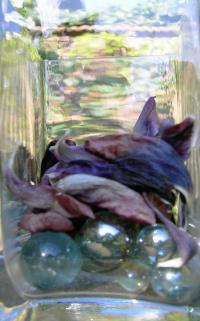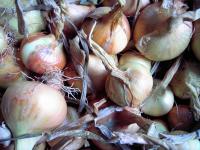die Gärten/the gardens
der Blumengarten / the flowergarden
BLOSSOMS ARE NATURES LOVE SONGS
AND THE SMILE THE CREATOR LEFT US
TO ALLWAYS REMEMBER WHAT WE ARE, WHERE WE COME FROM AND WHERE WE GO
HOME
ALL WAYS
„Blumen sind die Liebesgedanken der Natur.“
Bettine von Arnim
this flowergarden was not fertilized anyway the last 13 years
even not with compost
the system soustains itself
through the mixing of the plants
so that they nourish each other
normely we do not dig there or move the soil
cause it is all filled with roots and flower onions
this work are doing the worms the ants and much more busy insects
much thanks to them all

Dieser Blumengarten wurde 13 Jahre nicht gedüngt auch nicht mit Kompost
es ist ein geschlossenes sich selbst erhaltendes System
eine Permakultur
Gemüsegarten/vegetable gardening
Eating more sustainably to create a better future
Published: 27/08/2012
If everyone in the world ate at the same rate as people in the UK, we would need three planets to survive, according to a leading north-east academic.
Professor Peter Morgan, of Aberdeen University’s Rowett Institute of Nutrition and Health, said the world was unable to sustain the type of diet we have in the UK and we need to consider our dietary choices more carefully.
Prof Morgan – who will help host a special event at the British Science Festival next week – said it was more important than ever to understand how our guzzling is affecting the long-term sustainability of the world’s food supplies.
For the full story, pick up a copy of today’s Press and Journal or read our digital edition now
http://www.pressandjournal.co.uk/Article.aspx/2905917
Global Warming is an issue that impacts everyone, yet it is also is an issue where everyone can make an impact.
Simple everyday tasks, such as what food you buy, can either contribute to—or reduce—global warming. Rodale Institute research shows that organically managed soils can store (sequester) more than 1,000 pounds of carbon per acre, while non-organic systems can cause carbon loss. For consumers, this means that the simple act of buying organic products can help to reduce global climate change.
http://www.rodaleinstitute.org/http://www.rodaleinstitute.org/
Sandi´s herb gardens in Amerika

«Agnikultur - ein Weg in freie Welten: geheimes Wissen wiederbelebt & für Jedermann nutzbar gemacht»
Michael H. Wüst im Gespräch mit Michael Friedrich Vogt
Ein bekannter Spruch lautet: "Der dümmste Bauer erntet die dicksten Kartoffeln". Wie kann es schließlich sein, daß man tolle Ernteerfolge einfahren kann, ohne auf modernste Gentechnik und Pestizide zurückzugreifen? Womöglich liegt es daran, daß dieser doch eher sehr schlaue Bauer auf ein längst verschwundenes Wissen zurückgreift. Oder haben Sie schon einmal etwas von Agnihotra, Perma- oder Elektrokultur gehört?
Diese Techniken oder die Kombination daraus, war ein in vergangenen Jahrhunderten bekanntes und bewährtes Wissen mit hervorragenden Ernteerfolgen. Doch warum ist dieses Wissen verschwunden und wird heute nicht mehr angewendet? Die Antwort ist denkbar einfach. Gentechnik, Dünger und Pestizide sind ein Milliardengeschäft, während die altbekannten Techniken mit minimalem und preiswertem Aufwand betrieben werden können.
Agnikultur bezeichnet eine Kombination der verschiedenen Techniken die hier zum Einsatz kommen, nämlich Agnihotra und Perma- bzw. Elektrokultur. Agnihotra ist eine alte vedische Technik, ein Ritual oder Prozeß. Es werden dazu in einem speziell geformten Kupfertopf getrockneter Kuhdung, Butterfett und Reis verbrannt. Der Orga-Kult wiederum ist in den 30er Jahren entstanden und anscheinend an der schon aus dem 18. Jahrhundert bekannten Elektrokultur orientiert. Die Elektrokultur wurde bereits in Deutschland im 18 Jahrhundert verwandt, so wie auch in Frankreich. Diese vergessenen Techniken sind allerdings höchst förderlich für das Pflanzenwachstum und führen zu erstaunlichen Ergebnissen, welche man heute kaum für möglich hält.
Zusätzlich zum deutlich verbesserten Pflanzenwachstum durch Agnikultur hat sich als Nebeneffekt außerdem gezeigt, daß durch die Minderung oder gar Neutralisierung des Elektrosmogs in der Umwelt die eigene Gesundheit verbessert werden kann. Weitere Vorteile sind z.B. eine Entgiftung der Böden.
Die Förderung der Agnikultur wurde von Michael Wüst ins Leben gerufen um jedem zu ermöglichen mit minimalem Aufwand maximale Erfolge beim Gärtnern zu ermöglichen. Die Vorteile des effektiven Eigenanbaus sollten heute jedem bewußt sein. Denn neben maximalem Ernteerfolg verdient dieser tatsächlich den Begriff BIO.
Die Technik der Agnikultur ist dabei recht einfach zu erlernen. Michael Wüst beschäftigt sich seit vielen Jahren mit diesen Techniken und entwickelt sie stetig weiter. Sein Wissen über Agnihotra, Elektrokultur aber auch den Einfluß von geometrischen Körpern auf das Pflanzenwachstum gibt er in Workshops an Interessierte weiter. In nur wenigen Stunden ist es möglich, alles Wesentliche über die Herstellung und Pflege von Obst, Gemüse und Kräutern aus organischer Landwirtschaft in Verbindung mit Experimenten in Sachen Agnihotra, Orga-Urkult, Permakultur und anderen Methoden zu erlernen.
Auch auf seiner Webseite gibt Michael Wüst sehr viele nützliche Informationen zu diesen Themen. Durch einen Einkauf im angebundenen Onlineshop kann man dieses Projekt auch in finanzieller Form fördern und eine saubere, effektive und gesundheitsorientierte Landwirtschaft vorantreiben.
Webseite: www.agnikultur.de
" kann´st die Erde kneten
soll´st sie nicht betreten !"
Alte gärtnerweisheit
Watch out for that soft ground! - The soil food web
It turns out that the plants in your garden cannot take the nutrients they need directly from the soil or by photosynthesis. Most of the energy that results from photosynthesis in the leaves is actually used by the plants to produce chemicals and sugar's they secrete trough there roots known as exudates (A good analogy is perspiration, a human’s exudate)
All this secretion of exudates in the form of carbohydrates (including sugars) and proteins takes place in the rhizosphere, a zone immediately around the roots, extending about a tenth of an inch. The rhizosphere contains a constantly changing mix of soil organisms, including fungi, bacteria, nematodes, protozoa and other larger organisms. All this life competes for the exudates in the rhizosphere, or its water and mineral contents.
At the bottom of the soil food web are fungi and bacteria which are attracted to and consume plant root exudates. In turn they attract and are eaten by bigger microbes such as nematodes and protozoa. The nematodes and protozoa eat the fungi and bacteria (primarily for carbon) and anything they dont need is excreted as waste which plant roots are readily able to absorb as nutrients.
Plants control the food web for there own benefit . Studies indicate that individual plants can control the numbers and different types of fungi and bacteria attracted to the rhizosphere by the exudates they produce, all depending on the nutrients that the plant needs at that time of year.
The fungi and bacteria act as little bags of fertilizer, retaining in there bodies nitrogen and other nutrients they gain from root exudates and other organic matter. Protozoa and nematodes who come along an eat the fungi and bacteria act as fertilizer spreaders, They digest what they need and excrete excess carbon and other nutrients as waste.
The survival of the plant depends on the interplay between these microbes (Fungi, bacteria, nematodes and protozoa) and these microbes would not be there if it where not for the exudates from the plant. It is a completely natural eco-system the very same one that has fueled plants since they evolved.
The protozoa and nematodes that eat the fungi and bacteria and in turn feed the plants are eaten by arthropods (Insect and spiders) Soil arthropods eat each other and themselves are the food of snakes and other animals. While all this eating is going on members of the soil food web are moving around in search of prey or a place to hide and are having an impact on the soil.
The bacteria produce a slime, a result of which is that individual soil particles are bound together. Fungal hyphae, travel trough the soil sticking the particles together.
Worms along with insect larvae move trough the soil in search of food and protection, creating pathways that allow air and water to enter and leave the soil.
The soil food web in addition to providing nutrients to the roots also helps to create and improve soil structure.
A healthy soil food web is one that is not being destroyed by pathogenic and disease-causing organisms. A large and diverse community of soil life will control the trouble making organisms that will cause plant diseases by competing with them for the exudates and other nutrients, air, water and even space. If you have a healthy soil food web the competition will keep the pathogens in check, they may even be out competed to there death.
Chemical fertilizers, pesticides, insecticides and fungicides affect the soil food web, Toxic to some members, warding off others and changing the environment completely. Important fungal and bacterial relationships don’t form when a plant can get free nutrients. The trouble being you have to keep adding chemical fertilizers as the very foundation of the soil food web has been altered. Without the activity and diversity of a healthy soil food web, you not only impact the nutrient system but all the other benefits the healthy soil food web brings. Soil structure deteriorates and can become compacted, water can become problematic and pest and diseases are able to establish themselves and worst of all gardening becomes alot more work that it needs to be.
If the chemicals dont kill your soil, rototilling and digging will. This gardening rite of spring breaks up fungal hyphae, decimates worms and rips and crushes arthropods. It destroys soil structure and eventually saps soil of necessary air. Again this means alot more work for you.
So in short, stop adding -icides to your garden, stop digging your garden use mulch and other no dig methods instead (much less work on the aul back.) and leave the billions and billions of bacteria, fungi, nematodes, protozoa and all the other little animals do the work of digging your soil and feeding your plants, while you enjoy the benefits of a healthy soil food web and in turn healthy plants.
Most of the information here has been taking from the book Teaming with Microbes by Jeff Lowenfels and Wayne lewis (not me!) and the work of Dr. Elaine Ingham - www.soilfoodweb.com.
Wurzeln und Kräuter/ herbs and roots
Beinwellwurzeln Hollunderblüten Salbei Lavendel Ringelblume
Liebstöckelstaude Lungenkraut Veilchen Zitronenmelisse Kamille
Immer mehr Anbauflächen! Die Felder reichen häufig bis an die Siedlungen. Viele Anwohner beschweren sich inzwischen über den hohen Chemie-einsatz. Tatsächlich sind laut einer Studie die Gensojaflächen in Argentinien zwischen 1996 und 2003 um das 35-Fache gewachsen. Der Einsatz von Glyphosat aber im selben Zeitraum um das 56-Fache. Und bis heute wächst der Verbrauch von Glyphosat schneller als die Gensojafelder. Eine Erklärung: Das Unkraut reagiert immer unempfindlicher auf Glyphosat. Monsanto bestreitet das nicht.
Experten beobachten, dass nicht mehr nur Glyphosat gespritzt wird. So kritisiert der Agrarwissenschaftler Prof. Walter Pengue von der Universität Buenos Aires: „Der Landwirt muss zur Unkrautbekämpfung immer mehr Agrochemikalien einsetzen. Einer der zurzeit am häufigsten verwendeten Herbizidcocktails ist eine Mischung aus Glyphosat und 2,4 D, einem Herbizid, das weltweit seit den 1980er-Jahren nicht mehr landwirtschaftlich verwendet wurde, heute aber wieder eingesetzt wird."
Veröffentlicht am 29.04.2012 von parasitrix
RoundUp (Glyphosat mit anderen Chemikalien) ist ein Unkrautvernichter mit hinterhältigen Schadenswirkungen auf die menschliche Gesundheit. Über den hier beschriebenen Einsatz zur Unkrautbekämpfung bei Kleingärtnern hinaus macht der Stoff in der Landwirtschaft weltweit Bauern krank bei der gekoppelten Verwendung mit genmanipulierten Pflanzensaaten, und er verursacht Fehlbildungen bei Neugeborenen.
Experten weisen seit Jahren darauf hin.
Doch der Genkonzern Monsanto, die Herstellerfirma, wiegelt angesichts weltweiter Gewinne immer nur beharrlich ab und bestreitet jeden kausalen Zusammenhang.
Der RoundUp-Hauptwirkstoff Glyphosat ist eine Weiterentwicklung des einst im Vietnam-Krieg verwendeten hochgiftigen Entlaubungsmittels "Agent Orange", unter dessen Folgewirkungen bis heute in Vietnam Kinder mit Fehlbildungen zur Welt kommen.
Aber auch vervendete Zusatzstoffe stehen inzwischen unter dem Verdacht auf heimtückische Gesundheitsschädigungen.
Das Gift wird von verschiedenen Firmen unter Monsanto-Lizenz, z.B. als 'Glyphos' vermarktet.
Man tut gut daran, die Hände von RoundUp / Glyphosat zu lassen.
aufschlußreiche Informationen:
http://www.youtube.com/watch?v=d-XUtCTG1ZI
http://www.youtube.com/watch?v=8h6X5RjPkTI
http://www.heise.de/tp/artikel/17/17469/1.html
http://satyagraha.fboits.com/index.php/monsanto-mit-gift-und-genen/
http://de.wikipedia.org/wiki/Agent_Orange
http://www.tdh.de/was-wir-tun/projekte/suedostasien/vietnam.html
New Evidence Against These Cancer-Causing Foods - And the Massive Cover-Up Effort
June 09 2012 | 173,454 views | + Add to Favorites
1.3k Email | Print |
By Dr. Mercola
The World According to Monsanto is an absolutely brilliant documentary that should be on the required viewing list of virtually everyone on the planet. While it's already a few years old, the information it contains will remain current until we stop allowing genetically engineered crops to be planted altogether.
The film explains how the biotech giant Monsanto threatens to destroy the agricultural biodiversity that has served mankind for thousands of years. I must warn you though; it may bring tears to your eyes as you learn how they have decimated so many lives and part of the environment through their morally bankrupt behavior.
A Hostile Takeover of Our Food Supply
For millennia, farmers have saved seeds from season to season. Genetically engineered seeds have completely altered the agricultural landscape, as these seeds are patented, which means farmers must purchase new seed for each planting season and are not allowed to share or save any of the seed.
Doing so equates to patent infringement, and Monsanto has become notorious for tracking down and prosecuting farmers who end up with patented crops in their fields without having paid the prerequisite fees—even when their conventional or organic crops are contaminated by unwanted genetically engineered (GE) seed spread by wind or pollinating insects from neighboring farms that grow GE crops.
To do this, Monsanto relies on a shadowy army of private investigators and agents who secretly videotape and photograph farmers, store owners, and co-ops. They infiltrate community meetings, and gather information from informants about farming activities. Some Monsanto agents pretend to be surveyors. Others confront farmers on their land and try to pressure them to sign papers giving Monsanto access to their private records. Farmers call them the "seed police" and use words such as "Gestapo" and "Mafia" to describe their tactics.
For nearly all of its history the United States Patent and Trademark Office refused to grant patents on seeds, viewing them as life-forms with too many variables to be patented.
But in 1980 the U.S. Supreme Court allowed for seed patents in a five-to-four decision, laying the groundwork for a handful of corporations to begin taking control of the world's food supply. Since the 1980s, Monsanto has become the world leader in genetic engineering and modification of seeds; many, if not most of which are "Roundup Ready," meaning they can withstand otherwise lethal doses of the herbicide Roundup, also created and sold by Monsanto.
Most Commonly Used Herbicide Found to be Carcinogenic
As if the health hazards of genetically altered food crops weren't bad enough, glyphosate, the active ingredient in Roundup, has also been deemed a major health hazard both to the environment, and to animal and human health. It is toxic to human cells, and according to a French research team, it is also carcinogenic. The team has studied the herbicide extensively, and published at least five articles on glysphosate's potential for wide-ranging environmental and human harmi. Their research shows that glyphosate:
- Causes cell cycle dysregulation, which is a hallmark of tumor cells and human cancers
- Inhibits DNA synthesis in certain parts of the cell cycle—the process by which cells reproduce that underlies the growth and development of all living organisms
- Impedes the hatchings of sea urchins. (Sea urchins were used because they constitute an appropriate model for the identification of undesirable cellular and molecular targets of pollutants.) The delay was found to be dose dependent on the concentration of Roundup. The surfactant polyoxyethylene amine (POEA), another major component of Roundup, was also found to be highly toxic to the embryos when tested alone, and could therefore be a contributing factor
Monsanto-Funded Research Finds "No Evidence" of Harm from Roundup
It doesn't matter that the Journal of Toxicology and Environmental Health recently published "research" to the contraryii, the French team says―the world needs to know the truth about who did that "safety-finding" research. It was funded by none other than Monsanto itself! Is it any wonder they came to the conclusion that:
"[T]he available literature shows no solid evidence linking glyphosate exposure to adverse developmental or reproductive effects at environmentally realistic exposure concentrations."
The new Monsanto-funded safety research actually used the French team's original research to debunk the evidence that Roundup could have human or environmental safety issues. And that didn't sit well with the French team, which was so angered they wrote a detailed response to Monsanto's article, accusing the researchers of minimalizing the French group's work and publishing misleading information.
One of the Monsanto-backed team's major flaws was their total disregard for the scientific context within which their glysphosate research was performed―namely, the DNA-damaging and carcinogenic potential of the chemical.
Furthermore:
"The second flaw was the claim that their results were "not environmentally relevant" (repeated 5 times in the article), despite the fact that the French researchers were able to demonstrate toxicity in 100% of the individual cells at short exposure time below the usage concentration (20 mM) of the herbicide in present agricultural applications. They elaborated on this point further:
"Therefore, regarding the considerable amount of glyphosate-based product sprayed worldwide, the concentration of Roundup in every single micro droplet is far above the threshold concentration that would activate the cell cycle checkpoint. (2) The effects we demonstrate were obtained by a short exposure time (minutes) of the cells to glyphosate-based products, and nothing excludes that prolonged exposure to lower doses may also have effects.
Since glyphosate is commonly found present in drinking water in many countries, low doses with long exposure by ingestion are a fact. The consequences of this permanent long term exposure remain to be further investigated but cannot just be ignored," GreenMedInfo.com reportsiii:
Monsanto Guilty of Falsely Advertising Roundup as Safe
If you recall, in 2009, Monsanto was found guilty of false advertising by France's highest court, for claims that Roundup is biodegradable and leaves "the soil clean."
The French court noted that Roundup's main ingredient, glyphosate, is in fact dangerous for the environment and toxic for aquatic organisms. But that's just one example of the lies Monsanto tells to keep on selling its products; this company has a long history of fraudulent statements about the safety of Roundup. They long used the slogans, "It's Safer than Mowing," "Biodegradable," and "Environmentally Friendly" to describe their product—until the real effects of this toxic herbicide were revealed and they were forced to discontinue their deceptive advertising.
That still doesn't stop them from doing their best to continue misleading you by funding their own "safety studies." This is definitely a case where you'll want to make sure the research is truly independent...
You also cannot rely on government agencies to keep you safe from harmful genetically engineered foods. No, over the years, Monsanto has successfully infiltrated an ever increasing number of high-level federal regulatory positions in the U.S. government; many of which are positions meant to protectyour food safety.
Monsanto and Big Pharma—Another Unholy Alliance
Making matters even more complicated, not to mention more dire in terms of human health, Monsanto is also deeply entrenched with the pharmaceutical industry. Few people ever make the connection between genetically engineered crops and the sale of drugs, but there are strong financial ties between these two industries.
In 1995, The Upjohn Company—a pharmaceutical company founded in Michigan—merged with the Swedish pharmaceutical and biotech company Pharmacia AB, to form Pharmacia & Upjohn. In 2000, Pharmacia & Upjohn merged with Monsanto Company, at which time the name was changed to Pharmacia. The drug divisions, including Monsanto's old Searle drug division, were retained in Pharmacia, while the agricultural divisions became a wholly owned subsidiary of Pharmacia.
A short while later, Pharmacia spun off this agricultural/biotech subsidiary into a "new Monsanto" company. Pfizer then bought Pharmacia 2002, and today also owns the remainder of Upjohn. Bayer has also acquired certain assets.
As you can see, the past and present connections between all of these mega-corporations are dizzying in their complexity. When you consider the health hazards of genetically engineered foods, it's easy to recognize why you'd want to have a stake in the pharmaceutical industry as well, since drugs are the primary form of healthcare offered by conventional medicine today!
I believe genetically engineered food is one of the most significant challenges to your future health. And, the drug industry is one of the primary driving forces for the traditional paradigm, which focuses on the treating symptoms with expensive band-aids, so you get sicker and sicker and require more of their self-serving expensive drug solutions to relieve your symptoms. Put these two health disasters together – where one is feeding the profits of the other—and the picture becomes bleak indeed.
Why We Must Insist on Labeling of Genetically Engineered Foods
Labeling genetically engineered foods is likely the best shot we have at stopping the unchecked proliferation of genetically engineered foods in the US. We strongly support state initiatives, such as California's 2012 ballot initiative to require genetically engineered foods sold in the state to be labeled.
Many still don't fully appreciate this strategy. What you need to consider is that large food companies would likely refuse to have dual labeling; one for California and another for the rest of the country. It would be very expensive, not to mention a logistical and PR nightmare. To avoid the dual labeling, many would likely opt to not use genetically engineered ingredients in their product, especially if the new label would be the equivalent of a skull and crossbones label.
This is why we are so committed to this initiative, as victory here will likely eliminate most genetically engineered foods from the rest of the US as well.
Powerful confirmation of this belief occurred earlier this year, when both Coca-Cola Company and PepsiCo Inc. chose to alter one of their soda ingredients as a result of California's labeling requirements for carcinogensiv. This is a PERFECT example of the national impact a California GE labeling requirement can, and no doubt WILL, have. While California is the only state requiring the label to state that the product contains the offending ingredient, these companies are switching their formula for the entire US market, rather than have two different labels:
"Coca-Cola Co. and PepsiCo Inc. are changing the way they make the caramel coloring used in their sodas as a result of a California law that mandates drinks containing a certain level of carcinogens bear a cancer warning label. The companies said the changes will be expanded nationally to streamline their manufacturing processes. They've already been made for drinks sold in California."
Learn More about Genetically Engineered Foods
Due to lack of labeling, many Americans are still unfamiliar with what genetically engineered foods are. We have a plan to change that, and I urge you to participate and to continue learning more about genetically engineered foods and helping your friends and family do the same.
To start, please print out and use the Non-GMO Shopping Guide, created by the Institute for Responsible Technology (IRT). Share it with your friends and family, and post it to your social networks. You can also download a free iPhone application, available in the iTunes store. You can find it by searching for ShopNoGMO in the applications.
Your BEST strategy, however, is to simply buy USDA 100% Organic products whenever possible, (as these do not permit genetically engineered ingredients) or buy whole fresh produce and meat from local farmers. The majority of the genetically engineered organisms (GMOs) you're exposed to are via processed foods, so by cooking from scratch with whole foods, you can be sure you're not inadvertently consuming something laced with altered ingredients.
When you do purchase processed food, avoid products containing anything related to corn or soy that are not 100 percent organic, as any foods containing these two non-organic ingredients are virtually guaranteed to contain genetically engineered ingredients, as well as toxic herbicide residues.
To learn more about genetically engineered foods, I highly recommend perusing the many videos and lectures available on the IRT site.
Please Continue Supporting California's Ballot Initiative to Label GMO's!
The California Right to Know Genetically Engineered Food Actv has already been submitted to the State Attorney General. The next step is the campaigning. Remember, if California can get the law passed in November, it's going to have the same impact as national law, for the reasons I just mentioned.
It's going to be an enormous battle, as the biotech industry will outspend us by 100 to 1, if not more, for their propaganda. So needless to say, the campaign needs funds. If you have the ability, I strongly encourage you to make a donation.
I urge you to get involved and help in any way you can. Be assured that what happens in California will affect the remainder of the U.S. states, so please support this important state initiative, even if you do not live there!
- If you live in California and want to get involved, please contact LabelGMOs.org. Pamm Larry will go through all volunteer requests to put you into a position that is suitable for you, based on your stated interests and location
- No matter where you live, please help spread the word in your personal networks, on Facebook, and Twitter. For help with the messaging, please see LabelGMOs.org's "Spread the Word!" page
- Whether you live in California or not, please donate money to this historic effort via the Organic Consumers Fund
- Talk to organic producers and stores and ask them to actively support the California Ballot. It may be the only chance we have to label genetically engineered foods.
- For timely updates, please join the Organic Consumers Association on Facebook, or follow them on Twitter.
- Look for in-depth coverage of the issue at the Institute for Responsible Technology, subscribe to Spilling the Beans, and check out their Facebook or Twitter.
















 Dies ist eine mit page4 erstellte kostenlose Webseite. Gestalte deine Eigene auf www.page4.com
Dies ist eine mit page4 erstellte kostenlose Webseite. Gestalte deine Eigene auf www.page4.com